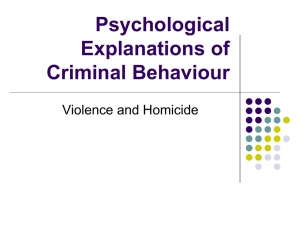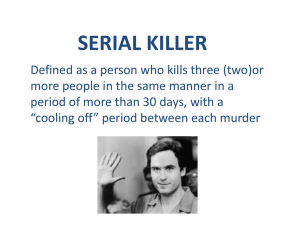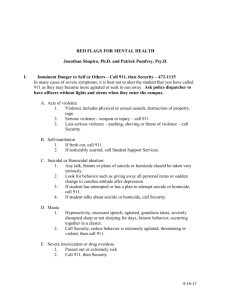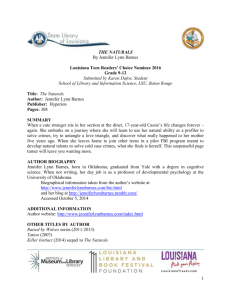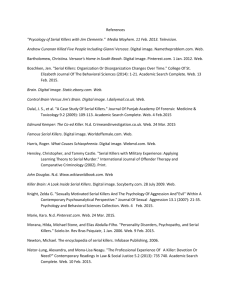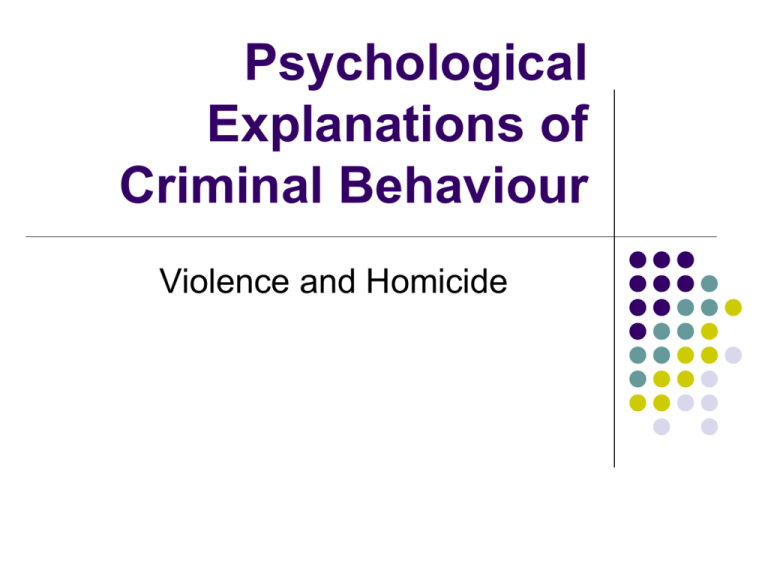
Psychological
Explanations of
Criminal Behaviour
Violence and Homicide
Definition of Dangerousness
Behavior likely to result in physical and/or psychological
trauma
Mental health professionals involved in predicting future
risk of dangerousness
Accuracy of prediction: a complex & controversial task
huge indicator is a hx of violent offending
Aggression & Violence
Aggression: behavior perpetrated or attempted
with the intention of harming another individual
physically or psychologically or to destroy an
object.
Violence: Actual, attempted, or threatened
physical harm that is deliberate and nonconsenting
Types of Aggression
Hostile (or expressive) aggression: occurs in
response to anger-inducing conditions, such
as real or perceived insults, physical attacks,
or one’s own failures.
Instrumental aggression: begins with
competition or the desire for some object or
status possessed by another person.
Violence as a Choice
The proximal cause of violence is a decision
to act violently
The decision may be influenced by a host of
biological, psychological, and social factors
Theoretical Perspectives on
Aggression
Frustration-aggression hypothesis: wanting to achieve or obtain a
desired goal but blocked frustration acting out aggressively
Social Learning: children learn, model/observe, their environment.
**Most research supports the notion that human aggression is
primarily learned (early learning and socialization).
Cognitive Models of
Aggression
Hostile attribution bias: individuals prone to
violence are more likely to interpret
ambiguous actions as hostile and threatening
Weak ability to control cognitions (i.e., poor
self regulatory controls) impulsivity (acting
out) violent outcome
How do people with apparently “good”
structures commit horrible crimes?
social learning theory: certain circumstance
breakdown in self-regulatory mechanisms
disengagement from conduct
Dehumanizing: serial killers view victims as
objects rather than humans
People will engage in conduct that goes against
their morals if dictated by authority
Overt and Covert Aggressive
Actions
Aggression
Behavior
patterns
Emotions
Cognitions
development
Overt
Direct
confrontation
with victims;
generally
decreases with
age
Anger; high
level of arousal
and violence
Lacks social
cognitions for
coming up with
nonaggressive
solutions
Aggression begins
early, especially for
boys
Covert
Concealment,
dishonesty,
sneaky
behavior,
increases with
age
Less emotion;
crimes such as
fraud, larceny
and theft
Relies on
Can evolve as well
cognitive
learned strategy to
capabilities, such escape punishment
as planfulness,
deceitfulness
Homicide
Homicide:
An act in which the life of one person is lost at the
hands of another.
Criminal homicide is murder when:
The perpetrator intended to cause death or bodily
harm likely to result in death.
First-, Second-degree murder, Manslaughter
Homicide
Incidence and Patterns (2002)
Frequency in Canada
582 criminal homicides (1% of violent crimes)
1.9 per 100, 000
Nature of Homicide in Canada
Location (Private residence, 60%)
Number of Victims (Lone victim, 94%)
Victims (Male, Young, Family Members)
Suspects (Male, Young, Known to victim)
Homicide
General View of Homicide
Reactive violence vs. Instrumental Violence
Homicide is often the final word in an argument arising
between people who know each other and who are
engaged in their normal activities
(Linden, 2004)
Homicide as “Crime of
Passion”
Cognitive Self-Regulation
Excitation Transfer Theory (Zillman, 1979, 1983)
Arousal produced in one situation can persist and
intensify emotional reactions occurring in
subsequent situations
Impairment of cognitive processes
Homicide as “Crime of
Passion”
Prior Event
An aversive earlier event
creates frustration,
emotional arousal.
Frustrating Event
Anger and frustration from
prior event influences
subsequent emotions and
appraisal of current events.
Cognitive Processes
Impaired and subsequent
actions are more impulsive.
Homicide as “Crime of
Passion”
Dispositional or Personality Perspective
Violent Men (Hans Toch, 1969)
Certain personalities more likely to react violently
in certain circumstances.
Violence can be traced to
Habitual response patterns
Past effectiveness in dealing with conflictual,
interpersonal relationships
Humiliation/Threats to reputation and status.
Homicide as “Crime of
Passion”
Dispositional or Personality Perspective
Edwin Megargee (1966)
The Undercontrolled offender:
Few inhibitions against aggressive behaviour.
Aggression becomes a habitual response when
angry/upset.
The Overcontrolled Offender
Well-established inhibitions against aggressive behaviour,
and rigidly adheres to them, even in the face of provocation.
When frustration and provocation overwhelm – excessive
violence
Homicide as “Cold
Calculation”
Multiple Murder
Serial murder:
Spree murder:
A minimum of three victims over time
Cooling-off period
Three or more victims without a cooling-off period,
usually at two or three different locations.
Mass murder:
Three or more victims at a single location with no
cooling-off period between the killings
Homicide as “Cold
Calculation”
Criminal Profiling
The process of identifying personality traits,
behavioural patterns, geographical habits, and
demographic features of an offender based on
characteristics of the crime.
Homicide as “Cold
Calculation”
Assumptions of the profiling process:
1.
2.
3.
4.
The crime scene reflects the personality
The offender’s personality will not change
The method of operation remains similar
The signature will remain the same
**This = the offender’s Modus Operandi (M.O.)
Homicide as “Cold
Calculation”
Assumptions of the profiling process:
Personation or signature
Anything that goes beyond what is necessary to commit
the crime.
Staging
The intentional alteration of a crime scene prior to the
arrival of the police.
Sexual Homicide
What is Sexual Homicide?
The intentional killing of a person during which
there is sexual behaviour by the perpetrator.
A sexual element (activity) as the basis for the
sequence of acts leading to death.
Sexual Killers
Slightly older, average age 28 years
Single
White, Aboriginal
Paraphilia (up to 50% of cases)
Sadism
Criminal History
(see Beauregard, 2012)
Sexual Killers - Victims
Female strangers
Female acquaintances
Males
White, Aboriginal – intraracial crimes
Drug or alcohol users
Prostitutes are frequent targets
Children can be also
Sexual Killers – What they do
Close contact killing techniques (hands,
beating, stabbing)
Disposed of body outdoors
Kept souvenirs
Only 10% had sex with body after death
Less than 5% on average mutilated body
parts
Many engaged in overkill
Many had sex with victim before death
Sexual Homicide
Organized Type
General traits:
Planning and
premeditation
Maintenance of control of
self and the victim
Often the victim is moved
from the abduction area
to another secluded area
Disorganized Type
General traits:
No premeditation or
planning
Impulsive, anger,
extreme excitement
Victim’s body left in
view; no alteration of
crime scene
Serial Killers
A Profile of the “Typical” Serial Killer
Diagnosis of Mental Illness
Age
Relatively older (Median age of 36 years)
Criminal History
Absence of Axis I disorders
Psychopathy, Major personality disorders
History of non-violent offences, No juvenile history
Geographic location
A large number select victims near their current
residence or place of work.
Serial Killers
Typology of Serial Killers
The Visionary Serial Killer
Motivation
Pattern of Homicide
Delusional visions and/or thoughts.
Highly disorganized; Spontaneous with little planning.
Ed Gein
He believed that by eating the corpses of women who
looked like his mother, he could preserve his mother's soul
inside his body (creating furniture with skin and body parts)
Serial Killers
Typology of Serial Killers
The Mission-Oriented Serial Killer
Motivation
A belief there is a particular group of people who are
undesirable and who must be destroyed or eliminated.
Not psychotic; Function on a day-to-day basis without
demonstrating aberrant behaviour.
Example: Peter Sutcliffe
Claimed voices told him to clean up the streets of
prostitutes (also had a fight with a prostitute for payment…
UK, prostitute user) – murdered 13 women
Serial Killers
Typology of Serial Killers
The Hedonistic Serial Killer
Motivation
Kills for the sheer pleasure
Aspect they enjoy varies
Lust Killer, Thrill Killer, Creature-Comfort Killer
Example: Dave Berkowitz (“Son of Sam”)
Got a thrill out of shooting young couples in cars at random
and then running away without ever physically touching the
victims (enjoyed publicity)
Serial Killers
Typology of Serial Killers
The Power/Control Serial Killer
Motivation
Pattern of Homicide
To gain and exert power over their victim
Ritualistic Elements
Example: Cameron Hooker
Kidnapped a woman and held her hostage as a sex slave
for several years (the woman in a box)
Serial Killers
Psychology and Development
Little valid empirical knowledge
The MacDonald Triad
1.
2.
3.
Some serial killers display one or more of the
following warning signs in childhood (un-validated
theory)
Fire-Starting
Cruelty to Animals
Persistent Bedwetting
Risk Assessment
only an aid to expert testimony
Relevant indicators for future crime
Previous violent conduct
Substance abuse hx
Young age
Risk Assessment Tools:
-HCR-20
-VRAG
-PCL-R
Risk Prediction
Will – Did (True Positive) Did Not (False
Positive)
Will Not – Did (False Negative) Did Not (True
Negative)
Will Commit
an offense
Will Not
Commit an
offense
Did do it
Did (True
Positive)
Did (False
Negative)
Did not
do it
Did not (False
Positive)
Did not (True
negative)
Risk Assessment tools
They change depending on recent research
Must stay up to date!
Must have the qualifications to use the tool
Must understand certain risk factors and
literature behind it
VRAG-R
Living with both parents until age 16 – no
Elementary school maladjustment – severe
History of alcohol or drug problems
Marital status – never married
Lots of previous nonviolent convictions
Failure on conditional release
Age at index offense (younger = more risk)
Lots of previous violent convictions
VRAG-R
Prior admissions to correctional institutions
(more = risky)
Conduct Disorder
Sex Offending (hands on, female adult)
PCL-R, facet 4, antisociality
HCR-20
Historical Scale (History of problems with...)
H1. Violence
H2. Other Antisocial Behavior
H3. Relationships
H4. Employment
H5. Substance Use
H6. Major Mental Disorder
H7. Personality Disorder
H8. Traumatic Experiences
H9. Violent Attitudes
H10. Treatment or Supervision Response
HCR-20
Clinical Scale (Recent problems with...)
C1. Insight
C2. Violent Ideation or Intent
C3. Symptoms of Major Mental Disorder
C4. Instability
C5. Treatment or Supervision Response
HCR-20
Risk Management Scale (Future problems
with...)
R1. Professional Services and Plans
R2. Living Situation
R3. Personal Support
R4. Treatment or Supervision Response
R5. Stress or Coping

